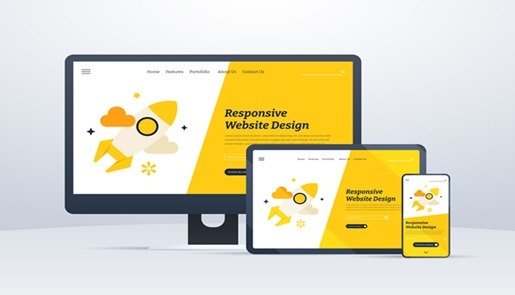Responsive Design Revolution: User-Centric Web Applications
If you own a development company or are a website or mobile application developer, you have surely noticed an increased client demand for responsive designs. This is brought about by the continued frequency with which Apple, Samsung, Xiaomi, and other mobile companies keep launching new phones with exceptional and experimental designs. And, every business wants to cater to all of its target users irrespective of their screen resolution.
As someone who has been in the technology industry, you surely know that this madness and trend won’t stop; which is why, we must focus on making our applications responsive. This has led to the Responsive Design Revolution which is so much more than pretty application designs and focuses on user interactivity.

Are you looking to learn more about the responsive design revolution and how you can become a part of it? If so, you’re at the right place; in the following article, we discuss what responsive design is and lay down some guidelines to help you. So, jump right into the article and get started with learning more about the responsive design revolution that has taken the tech industry by storm.
What exactly brought about the Responsive Design Revolution?
Do you remember those days when you had to visit the nearest cyber cafe to surf the Internet for a few hours? Today, the Web is accessible from everywhere, which has changed the complete trajectory of web usage and helped it evolve over the past few years. With smartphones and the internet becoming cheaper, more and more people are adapting to these devices; hence, users look for consistent and engaged user experiences irrespective of their device and location.
We also need to account for the usage of multiple devices by the same user and must ensure an exceptional experience for all. But, how exactly do you do that? Since you can’t develop different business websites catering to different screen resolutions, you must move away from thinking about the gadget; instead, try focusing more on the user and their needs. This is a key concept that led to the popularity of the responsive design revolution and led to increased business focus on user preferences and needs.
What is Responsive Design? – A complete breakdown of this integral web design concept
According to Ethan Macrote, an expert who has highly contributed to the Responsive Design Revolution, the concept arises from a similar notion, i.e. responsive architectural design. In this field, the term responsive refers to the fact that architects automatically adjust a room or space they designed based on the number and the flow of people it contains.
You can easily translate this into web design in this way – rather than creating a completely new Web Design for a different screen size, why not make a web design that automatically adjusts? This will allow you to avoid developing infinite custom-made solutions to simply cater to all of your users with different devices.
Since building motion sensors and including robotics to do so is not possible, you need to base your design on flexible layouts and scripts that reformat your website’s design. However, an important point that you must note here is that responsive web design does not revolve only around adjustable screen sizes and media; instead, you must think of it as a whole new way of designing applications.
What are some key components of Responsive Design?
Before we jump right into how you can focus on creating seamless user experiences, let us explore some key concepts that you must keep in mind.
1. Desktop-First and Mobile-First Approaches
Two commonly-used strategies in Responsive Design Revolution are Mobile-First and Desktop-First; and, the debate has been floating for years. We recommend you choose the Mobile-First strategy if you prioritize efficiency and are looking to seamlessly transition to devices with larger resolutions. The Desktop-First strategy refers to the practice in which designers first focus on developing the website for desktop users, followed by designing the same for smaller resolutions.
2. Scalable Resources like Images and Other Media Elements
Since visuals can help you easily convey information to users, they are quite popular; but, you must ensure that they are managed securely across all of your website’s platforms. We recommend you look into CSS’s properties like max-width and min-width that help you preserve the quality of your media resources like images and videos.
3. Typography and Added Readability across Devices
Your text’s font and other elements can greatly affect user experience, which is why you must focus on using the right typography across all user devices.
How can you create seamless user experiences with responsive web design concepts?
Now that you have an idea about the important concepts in the Responsive Design Revolution, let us discuss how you can focus on creating seamless user experiences.
1. Website Consistency across Devices
You have surely seen people using multiple devices (mobiles, tablets, and desktops) throughout their day; so, you must keep in mind that your website content must be optimized for all of these devices. A tip for you – maintain the same aesthetic and brand identity across all the devices that you are optimizing your website for.
2. Intuitive Navigation for Smartphones
Mouse navigation is quite different from intuitive navigation; and, owing to increased mobile usage, you must ensure that your application caters to intuitive navigation and touch interactions. This is a true principle that accurately showcases the benefit and necessity of the responsive design revolution.
3. Designs for Different Screen Orientations
An important concept in responsive design is that different users might use your app in different layouts (specifically, portrait and landscape); and, you must ensure that your web or mobile application’s design is consistent across these layouts and engages the user.
Some important principles of Responsive Design that can help
Are you interested in dipping your toes in the Responsive Design Revolution, but do not know where to start? In this section, we will discuss some important principles and concepts of the Responsive Design Revolution that you must keep in mind. You can implement these to get started with Responsive Design and experiment further once you have got the concepts down.
1. Adjusting Screen Sizes and Resolutions
As we see more and more devices with different screen sizes, resolutions, and orientations being launched, we must become mindful and ensure that our design caters to each of these situations. Since it is impossible to account for this wide variety of screen sizes while designing your website, it is better to group them into different categories. However, this might become quite exhausting after some time and still leaves room for huge errors.
This is why we recommend using flexible layouts where your image automatically resizes and your website’s content layout is changed. An important point that you must remember when designing responsive websites is accounting for the minimum screen size; this is because minimizing the website too much can break the content and its layout, making for a clumsy look and reduced user experience.
2. Custom Layout Designs and Structures
In the case of extreme size changes, we recommend you consider changing your website’s design with CSS media queries. With numerous media queries and features available in newer CSS versions, designing custom layouts and structures for your website has become quite easy.
3. JavaScript
Mostly used as a backup in case CSS styles and media queries for a website do not work, JavaScript is a great way to implement responsive website designs. An important point that you must note is that some older browsers do not support CSS media queries; but, you can easily work around these with JavaScript codes and can implement custom layouts and website designs.
Some important SEO and Accessibility Considerations that can help your website
Other than creating responsive websites for added user flexibility, numerous businesses invest in it due to the added SEO points they get. To help you better understand how taking part in the responsive design revolution can help you, we have listed a few SEO and accessibility points that you must consider.
1. Mobile-Friendly Contributes to Rankings
Since responsive websites are great for mobile users, they get more users, which also means that Google boosts them.
2. Structured Data Helps Ensure Better and Richer Results
You will notice that your development team implements responsive design using schema markups that create structured data. This enables the search engine to better understand the website content and the data available, helping increase the website’s ranking.
3. Responsive Website Design and Accessibility
When your website has a responsive design, it is easily accessible; this simply means that your website can cater to a larger number of users. So, users do not move out of your site and have a satisfying experience, which helps boost your website’s search engine rankings.
Responsive Design Revolution – An Insight Into The Future
Now that you have an idea about what the responsive design revolution is all about, let us have a look into what the future has in store for us.
1. Increased Usage of IoT Devices and Wearables
As more and more people are using wearables like smartwatches, developers must become mindful of these devices. We predict that the future of the responsive design revolution will be more focused on IoT devices and wearables.
2. Implementation in Progressive Web Apps (PWAs)
PWAs are a great way to enhance user experience while increasing the site’s responsive capabilities, which is why we predict a boost in the number of businesses using PWAs.
3. Voice User Interface (VUI)
As more and more people are using voice commands to conduct searches, we think developers will need to be mindful of voice patterns and ensure that their applications are capable of properly interacting with them.
Conclusion
Now that we have reached the end of our article on the Responsive Design Revolution, you can surely see that it is more than a simple web development trend and holds a lot of potential. It can not only help businesses better cater to their existing customers; but, can also help them reach the top. So, we recommend you get started with responsive website designs and dip your toes into the responsive design revolution as quickly as possible!





